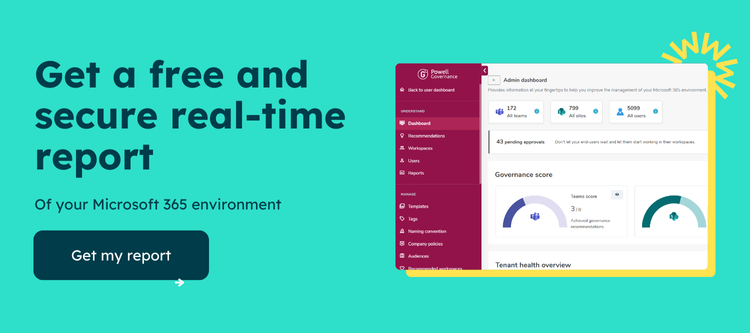Why is Microsoft Teams Governance and Compliance Essential?
Microsoft Teams, in all its efficiency and versatility, can quickly become a maze of scattered data, redundant teams, and uncontrolled external sharing if left unchecked. This is where Microsoft Teams governance and compliance come into play.
A comprehensive governance strategy for Microsoft Teams helps you avoid these pitfalls, ensuring that your Teams environment remains structured, data is secure, and users are following prescribed policies. Ineffective Microsoft Teams governance and compliance protocols can leave the door wide open for unauthorized access, data breaches, and non-compliance with industry regulations, all of which can result in hefty penalties and loss of trust among customers.
Beyond preventing security incidents, robust governance enhances the user experience. It results in a well-structured Teams environment where content is easy to locate, reducing user frustration and improving efficiency.

Best Practices for Microsoft Teams Governance and Compliance
Establishing a Robust Governance Framework for Microsoft Teams
Setting up a strong governance framework is the cornerstone of Microsoft Teams governance and compliance. This framework includes defining who in the organization can create new teams and what naming conventions they should follow. A well-structured Teams environment with clear naming conventions will help your users navigate the system effectively.
Part of this framework should also involve the lifecycle management of teams. Determine how to handle inactive teams, whether through archiving or deleting, to prevent an accumulation of outdated content.
Another aspect of the governance framework is managing guest access. Although Teams allows for seamless collaboration with external users, it’s important to set clear guidelines for guest access to protect sensitive data and maintain control over your Teams environment.
Finally, the governance framework should also cover the use of third-party apps within Teams. While these apps can enhance functionality, unregulated use can pose security risks. Therefore, it’s essential to determine which apps are allowed and who can install them.
Implementing Access Controls and Permissions to Ensure Compliance
In addition to setting up the governance framework, implementing access controls and permissions is a key component of Microsoft Teams governance and compliance. These controls help ensure that only authorized individuals have access to certain data, and even then, only to the extent necessary for their role.
Monitoring and Auditing Microsoft Teams Activities for Regulatory Requirements
Consistent monitoring and auditing of your Teams activities are critical for maintaining governance and compliance. By keeping track of user activities, file sharing, and team interactions, you can identify and address any potential breaches or non-compliance issues promptly.
Microsoft provides the Security & Compliance Center, which offers comprehensive auditing and reporting capabilities. It allows you to review user activities, assess compliance with data regulations, and even set up alerts for specific activities. This tool can be invaluable in your efforts to maintain Microsoft Teams governance and compliance.

Tools and Features for Microsoft Teams Governance and Compliance
A variety of tools and features, both within Teams itself and from third parties, can support your governance and compliance efforts. For instance, Teams offers built-in features like access controls, data loss prevention policies, and audit logs. These can help you manage data security, monitor user activities, and maintain compliance.
In addition to the built-in Teams features, third-party solutions like Powell Software can further enhance your Microsoft Teams governance and compliance efforts. Powell Software provides additional capabilities such as customizable Teams templates, detailed usage analytics, and automated workflows, among other features. These can greatly improve your governance strategies, making management easier and more efficient.

Ensuring User Adoption and Training
Communicating Governance Policies and Guidelines to Teams Users
Communication is key when it comes to Microsoft Teams governance and compliance. Your users need to be aware of the governance policies in place and, more importantly, understand why they are necessary. Regular updates and reminders about these policies can help keep governance at the forefront of their Teams usage.
Providing Training and Resources for Teams Governance and Compliance
Training your users can greatly improve their compliance with governance policies. Consider providing training sessions, webinars, or e-learning resources that cover the essentials of Microsoft Teams governance and compliance. The more knowledgeable your users are, the more likely they are to follow the best practices.
Addressing Common Challenges and Driving User Engagement in Compliance Practices
User engagement can be a challenge when it comes to compliance practices. One way to overcome this is by making compliance easier for users. This could involve simplifying governance policies, providing easy-to-follow guidelines, or even automating compliance processes where possible.
Encourage your users to actively participate in maintaining compliance. Make them understand the benefits of compliance, not just for the organization but also for their own Teams experience. Regular feedback sessions, rewards for compliant behavior, and quick resolution of user issues can go a long way in driving user engagement in compliance practices.
To wrap up, Microsoft Teams governance and compliance require a strategic approach that combines robust planning, effective use of tools, and proactive user engagement. With the right practices and tools in place, you can transform your Teams environment into a secure, compliant, and efficient digital workplace.
Ready to take your Microsoft Teams governance to the next level? Register now for a demo with Powell Software and see how our solutions can revolutionize your governance and compliance strategies.


